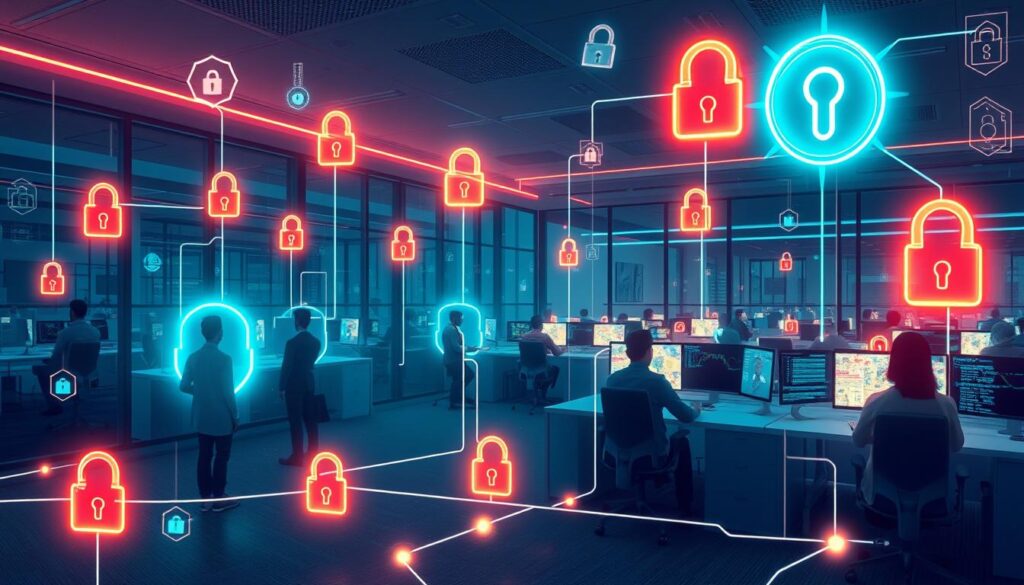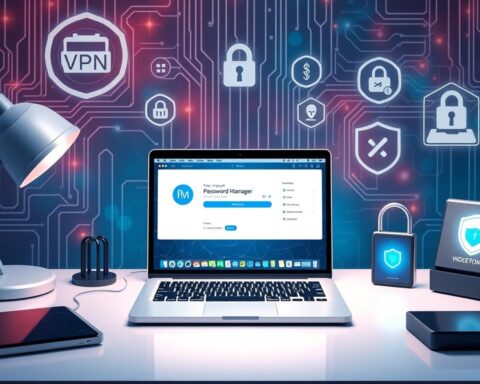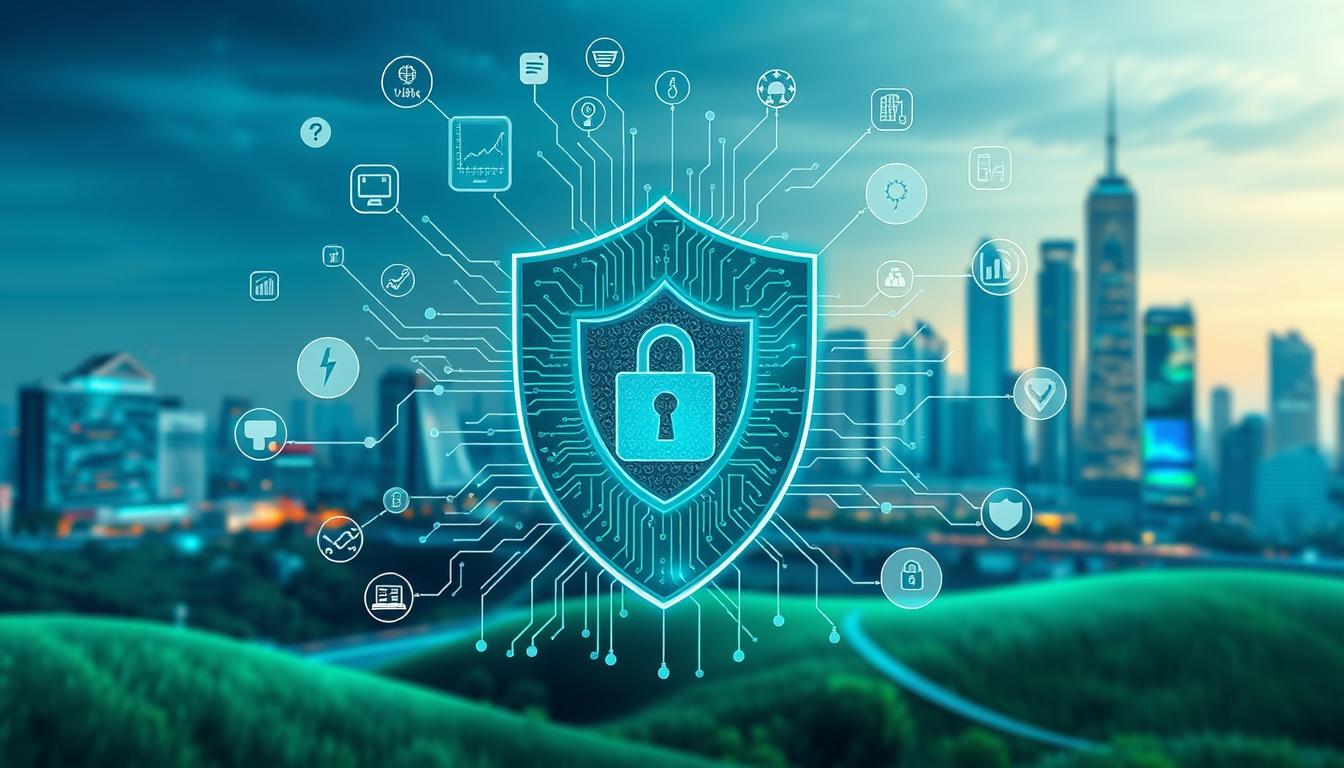Did you know that about 20% of companies have faced data breaches because of former employees1? This shows how vital human resources and security are today. Businesses must handle the employee lifecycle well, from start to finish, with strong security.
Now, with 72% of tech companies having staff work outside offices, keeping things secure is harder1. This guide will show how HR and security work together. It will help protect employees and data at every job stage.
Every step in a person’s job, from starting to leaving, has its own security needs. We’ll look at how to onboard safely, train continuously, and offboard securely. These steps help lower insider threat risks and build a cybersecurity-aware culture.
Key Takeaways
- Effective security measures throughout the employee lifecycle are key to reducing risks.
- Secure onboarding sets the stage for a strong security culture.
- Ongoing training keeps everyone alert to new cyber dangers.
- Good offboarding stops data breaches from ex-employees.
- Role-Based Access Control (RBAC) helps manage security permissions well.
- Remote work needs special security rules and training.
- Regular security checks and compliance are essential for a strong defense.
Understanding the Critical Role of HR Security in Modern Organizations
HR security has changed a lot in recent years. Now, onboarding and offboarding are key parts of keeping an organization safe. This shows how important information security and cybersecurity awareness are in the workplace.
The Evolution of HR Security Practices
HR security has moved from simple rules to complex systems. Background checks are now a big part of hiring, making sure only the right people get jobs2. Companies use role-based access control to prevent data misuse2.
Current Challenges in HR Security Management
HR managers face big challenges in keeping things secure. With more people working from home, onboarding gets harder. New employees often don’t get help from their peers right away3.
Many companies also struggle to give new hires access to what they need quickly. This can slow down how well they do their jobs. Surveys show it can take up to three weeks to get the tools they need3.
Impact on Organizational Risk Management
Good HR security practices help manage risks. Regular security training keeps everyone on the same page2. Companies that do onboarding well keep their employees longer3.
But, offboarding can be a big risk if not done right3. In 2024, over 500 big tech companies let go of more than 140,000 people. This shows how important it is to have good offboarding plans4.
| HR Security Aspect | Impact on Risk Management |
|---|---|
| Background Checks | Reduce workplace crimes |
| Security Awareness Training | Enhances information security |
| Role-Based Access Control | Mitigates data misuse risks |
| Effective Offboarding | Improves employer brand and security |
As companies look for new talent, HR security is more important than ever. A good offboarding process can help attract new employees. By linking HR with risk management, companies can be safer and more secure.
Human Resources and Security: Onboarding, Offboarding, and Ongoing Training
Effective workforce management needs strong security at every step. This includes onboarding and offboarding. It’s key to protect assets and follow rules. Companies with good onboarding see new hires work better by 54%5.
Onboarding is the start of an employee’s time at the company. It teaches them about the culture, how things work, and security rules. A good onboarding can keep employees for 25% longer in the first year5. It also includes training on keeping identities safe and following security rules.
Training is vital for a safe work place. Companies with learning systems see a 42% boost in employee happiness5. Keeping up with security and rules is part of this training.
Offboarding is also key. Yet, 40% of employees don’t get a proper goodbye, risking legal and compliance issues5. A detailed offboarding checklist helps avoid these problems. It makes sure all access is taken away and company things are back.
| Process | Impact | Best Practice |
|---|---|---|
| Onboarding | 54% greater productivity | Structured training program |
| Ongoing Training | 42% increase in engagement | Use of learning management systems |
| Offboarding | Reduced legal and compliance risks | Comprehensive exit checklist |
Adding security to each part of an employee’s time at a company makes a strong defense. It also keeps rules followed. This way, a culture of security and responsibility grows among employees.
Essential Components of Secure Employee Onboarding
A good employee onboarding process is key for keeping your company safe and productive. Companies with solid onboarding see new hires work 54% better and keep employees 82% longer6. This shows how important it is to start with strong security measures.
Pre-arrival Security Preparations
Before a new employee starts, do deep background checks and set up security clearances. This step helps avoid risks and makes the employee’s first day easier.
First-day Security Protocols
On the first day, introduce new employees to your cybersecurity rules. Good onboarding can make employees more likely to stay for three years, with 69% staying longer6.
Access Management and Control Systems
Using role-based access control (RBAC) is key for keeping data safe. Cloud-based HR platforms make onboarding faster and more efficient7. These systems control who can access what, lowering security risks.
Documentation and Compliance Requirements
Having the right documents is vital for following rules and keeping your security policies in check. Yet, 30% of employees say they didn’t get enough info security training6. So, give detailed security training and make sure new hires understand and agree to these policies.
| Onboarding Component | Impact on Security | Best Practice |
|---|---|---|
| Pre-arrival Checks | Reduces possible insider threats | Do deep background checks |
| First-day Protocols | Starts a security-first mindset | Give a full security briefing |
| Access Management | Lessens unauthorized access | Use an RBAC system |
| Documentation | Keeps compliance and accountability | Keep detailed records of training and policy confirmations |
By focusing on these key areas, companies can build a secure base for new employees. This helps create a culture of cybersecurity awareness right from the start.
Building a Robust Security Training Program
A solid security training program is key to a company’s cybersecurity plan. It’s all about keeping employees up-to-date through ongoing training. This approach can cut breach risks by 70%8.
Starting with a strong onboarding process is vital. It boosts new hire productivity by 50% and employee engagement by 69%9. This sets the stage for a culture that values security.
Training should be tailored to each role. This targeted method, along with regular updates, keeps employees informed about new threats. Role-based access controls can cut unauthorized access by 50%8.
Interactive training methods are more engaging and effective. Phishing simulations can lower attack risks by 30%, and gamified training can increase interest by 50%8. These methods make learning fun and practical.
| Training Method | Impact |
|---|---|
| Regular Phishing Simulations | 30% reduction in phishing susceptibility |
| Gamified Security Training | 50% increase in engagement levels |
| Continuous Learning Workshops | 40% increase in knowledge retention |
It’s important to check how well training is working. Regular checks on access can lower insider threats by 40%8. This ensures the training stays effective and relevant.
By focusing on continuous training and awareness, companies can lower their risk a lot. With 80% of breaches due to untrained employees, a strong training program is a must for today’s businesses10.
Implementing Effective Offboarding Security Measures
Offboarding is a key process that needs careful security focus. When employees leave, companies must quickly protect sensitive data and control access. A well-planned offboarding process can cut insider threats by 25% after an employee goes11.
Access Revocation Procedures
Quick action is essential in removing access rights. Sadly, 57% of companies don’t remove software application access right away after an employee leaves11. To lower risks, IT teams should follow a checklist:
- Disable user accounts across all systems
- Remove access to cloud services and applications
- Change shared passwords and access codes
- Revoke VPN and remote access privileges
Data Protection During Transition
Keeping company data safe during offboarding is vital. Without proper offboarding steps, 40% of companies face data breaches from former employees or contractors11. To protect sensitive info:
- Monitor data access and transfer activities
- Implement data loss prevention tools
- Do exit interviews to remind departing employees of confidentiality
Equipment Recovery and Security Protocols
Getting back company-owned devices is a key offboarding step. To protect data:
- Create an inventory of all company-issued devices
- Securely wipe data on returned equipment
- Check the return of physical access items (keycards, badges)
By using these offboarding security steps, companies can greatly lower risks from employee departures. Companies using Identity and Access Management systems see a 75% drop in onboarding errors and security issues, which also applies to offboarding11.
| Offboarding Security Measure | Impact |
|---|---|
| Structured Offboarding Process | 25% reduction in insider threats |
| Prompt Access Revocation | Mitigates unauthorized access risks |
| Data Protection Protocols | Prevents data breaches linked to ex-employees |
| Equipment Recovery | Ensures company data security on devices |
Good offboarding is not just about security; it also boosts employee satisfaction and company success. Research shows that happy offboarding experiences lead to higher job satisfaction, which can improve future company interactions12.
Role-Based Access Control (RBAC) in HR Security
Role-Based Access Control (RBAC) is key in today’s identity management. It makes sure employees get the right access for their jobs. This lowers the risk of misuse and boosts security13.

Defining Access Levels
RBAC divides security into roles, permissions, users, and rules14. This setup lets HR and IT set up access levels for each job. It makes work smoother and cuts down on access problems13.
Managing Permission Hierarchies
Managing permissions well is key for strong access control. HR is important in this:
- Onboarding: HR gives new employees the right access right away.
- Role transitions: Changing permissions stops “privilege creep” when roles change.
- Offboarding: Taking away access for leaving employees is vital for security13.
Monitoring and Adjusting Access Rights
Checking access controls often is vital for security and following rules. HR works with IT for these checks. They make sure no one has too much access and follow the law13. Tools like CloudEagle.ai help by making these tasks easier and keeping data safe14.
| RBAC Component | HR Responsibility | Security Impact |
|---|---|---|
| Access Definition | Align roles with job functions | Reduced risk of over-privileged users |
| Permission Management | Coordinate role transitions | Prevention of privilege creep |
| Access Monitoring | Conduct regular audits | Ongoing compliance and security |
By using RBAC and working together, HR and IT can build a strong security system. This system keeps data safe while helping employees do their jobs well.
Cybersecurity Awareness Training for Employees
Cybersecurity awareness training is key to protecting companies from digital threats. With 74% of breaches involving people, teaching employees is essential15. A good training program can cut security breach risks by up to 70% and build a strong security culture. This makes companies 33% less likely to face cyber attacks16.
Effective cybersecurity awareness programs cover important topics:
- Password policies and multi-factor authentication
- Phishing scam identification
- Software update importance
- Sensitive data handling
Ongoing training is key for managing the workforce. Regular updates keep employees informed on the latest security rules. This is cost-effective, as investing in education is cheaper than dealing with data breaches15.
Training should teach staff to act fast in case of security issues. It’s worrying that 60% of employees use the same password everywhere, and 23% might fall for phishing scams16. These facts show the need for thorough training.
“Establishing a security culture early is easier and less costly than changing ingrained habits later.”
Compliance is also vital. Security awareness training helps meet standards for SOC 2, ISO 27001, GDPR, and HIPAA15. Companies can avoid big fines by focusing on employee education.
| Training Impact | Percentage |
|---|---|
| Risk reduction in security breaches | 70% |
| Employees unsure about recognizing phishing | 58% |
| Organizations reporting reduced human error breaches | 78% |
By using effective cybersecurity awareness training, companies can greatly improve their security. They can also create a culture of alertness among their employees.
Monitoring and Compliance in HR Security
Monitoring and compliance are key to a strong HR security framework. They help reduce risks and make operations more efficient.
Audit Trails and Documentation
Audit trails and detailed documentation are vital for tracking access and policy changes. Regular audits can spot and fix non-compliance issues early, reducing risks. This proactive approach can also improve HR compliance by up to 35%17.
Regulatory Compliance Requirements
Understanding complex regulations is a key part of HR security. Cloud-based HR platforms can cut down on compliance errors by 25% compared to traditional methods5. Focusing on data protection can lower data breach risks by about 45%17.
| Compliance Action | Impact |
|---|---|
| Regular policy updates | 50% boost in employee awareness and compliance rates17 |
| Compliance training | 40% higher adherence to workplace safety standards17 |
| HR technology adoption | 40% increase in compliance with labor laws5 |
Security Incident Response Planning
Creating solid security incident response plans is vital for quick recovery and damage control. Companies with robust HR systems see a 20% jump in employee engagement, leading to better security awareness5. Safety training can cut workplace accidents by up to 60%17.
It’s important to blend information security and cybersecurity into compliance training. Regular training can lead to a 40% higher adherence to safety standards, showing the value of ongoing education in a secure work environment17.
Best Practices for Remote Employee Security Management
Remote work is now a big part of our jobs. With 72% of tech firms working with staff outside their offices, keeping remote workers safe is key. Good offboarding helps keep cybersecurity strong in teams spread out.
Starting with strong security during onboarding is important. Use two-factor authentication and VPN to keep data safe18. This can make work 25-30% more efficient and make employees 70% more engaged19.
Having clear rules for remote work is also key. Companies that set clear rules see new employees perform 10-20% better19. Keeping in touch regularly, like weekly, can keep new hires 50% longer19.
“A structured onboarding program can reduce the time it takes for new hires to reach full productivity by 50%.”
For offboarding, using automation helps close accounts fast. Some say they can do it in just 4 minutes18. After offboarding, checking that all accounts are closed is important for security.
| Remote Work Best Practices | Impact |
|---|---|
| Structured Onboarding | 25-30% productivity boost |
| Clear Expectations | 10-20% performance increase |
| Weekly Check-ins | 50% higher retention |
| Modern Device Management | 40% fewer IT support requests |
By following these best practices, companies can keep their cybersecurity strong. This lets them enjoy the benefits of a flexible, remote team. Remember, managing remote workers well is an ongoing job that needs constant effort and change.
Conclusion
The mix of human resources and security is key to keeping modern companies safe. Good onboarding can make new hires 70% more productive and keep them 25% longer20. This shows how important it is to welcome new employees well into the company culture.
Training and growth are vital for a safe team. Companies that train see a 24% profit boost and 37% less turnover20. This proves the need for ongoing security lessons and access controls to handle risks well.
Offboarding is also very important, but often ignored. A good offboarding can cut turnover by 15% and make ex-employees more likely to recommend the company20. Yet, only about 30% of companies have a clear offboarding plan21. It’s key to have detailed offboarding steps, like sharing knowledge and recovering assets, to keep the company safe and respected.
By focusing on HR security at every stage, companies can build a strong and safe team. As threats grow, it’s important to keep improving these strategies. With a forward-thinking approach to HR and security, businesses can safeguard their assets, build trust, and grow in the digital age.
FAQ
Why is HR security important in modern organizations?
What are the key components of secure employee onboarding?
How can organizations implement effective offboarding security measures?
What is Role-Based Access Control (RBAC) and why is it important in HR security?
How can organizations develop an effective cybersecurity awareness training program?
What are the best practices for securing remote workforces?
How does HR security impact talent acquisition and workforce management?
What are the key challenges in HR security management today?
How can organizations ensure compliance in HR security practices?
What role does ongoing training play in maintaining HR security?
Source Links
- Best practices for securely onboarding and offboarding employees – https://www.notchup.com/insights/securely-onboarding-and-offboarding-employees
- (Blog) Understanding HR Security Basics for ISO 27001 & NIS2 Compliance | Academy | Cyberday.ai – https://www.cyberday.ai/blog/hr-security-basics-iso-27001-nis2
- Challenges of Employee Onboarding and Offboarding with Craig Davies – Easy Prey Podcast – https://www.easyprey.com/challenges-of-employee-onboarding-and-offboarding-with-craig-davies/
- 3 Offboarding Best Practices Every HR Expert Should Know for 2025 – https://www.bamboohr.com/blog/offboarding-why-it-matters
- Streamline Onboarding and Offboarding With the Right HR Technology – Employer Services Insights – https://www.experian.com/blogs/employer-services/streamline-onboarding-and-offboarding-with-hr-technology/
- Onboarding And Offboarding Employees For Risk Prevention – Scrut Automation – https://www.scrut.io/post/a-guide-to-onboarding-and-offboarding-employees-for-risk-prevention
- What is employee onboarding and offboarding? | Definition from TechTarget – https://www.techtarget.com/searchhrsoftware/definition/employee-onboarding-and-offboarding
- 5 Security Awareness Tips: User Onboarding and Offboarding – https://ironcovesolutions.com/blog/5-security-awareness-tips-for-user-onboarding-and-offboarding
- Maximizing Employee Onboarding and Offboarding with HRIS – https://www.outsail.co/post/the-role-of-hris-in-employee-onboarding-and-offboarding
- Cybersecurity Training for Employees: The Non-Technical Guide – https://blog.uniqkey.eu/cybersecurity-training-for-employees/
- How To Make Onboarding And Offboarding Effective And Secure – https://www.linkedin.com/pulse/how-make-onboarding-offboarding-effective-secure-hari-subedi-7g1hf
- HR 101 | Employee Onboarding & Offboarding – https://www.bamboohr.com/hr-101-guide/chapter-4-onboarding-and-offboarding
- The Critical Role of Human Resources in an Information Security Program – https://www.linkedin.com/pulse/critical-role-human-resources-information-security-program-merle-t6hbe
- Role-Based Access Control (RBAC): The Key to IT Security Success | CloudEagle.ai – https://www.cloudeagle.ai/blogs/role-based-access-control
- Get started with security awareness training – https://www.vanta.com/resources/security-awareness-training-101-get-your-startup-ready
- Security Awareness & Training | KnowBe4 Threat Testing – https://www.hungerford.tech/managed-it-services/cybersecurity/security-awareness-training/
- HR Compliance Checklist – https://www.manifest.ly/use-cases/systems-administration/hr-compliance-checklist
- Employee Onboarding and Offboarding Remotely: 6 Tips Every IT Manager Needs to Know – Esevel – https://esevel.com/blog/employee-onboarding-and-offboarding
- Remote Employee Onboarding Checklist for HR & IT Administrators – https://www.trio.so/blog/remote-employee-onboarding/
- Onboarding and Offboarding: A Comprehensive Checklist – https://www.wrike.com/blog/nailing-onboarding-and-offboarding/
- Employee Onboarding and Offboarding is Important. – https://corbanone.com/why-your-offboarding-strategy-is-just-as-important-as-onboarding/







